Language of Remembrance: Ella Ponizovsky Bergelson on “Lay-lah Lay-lah”
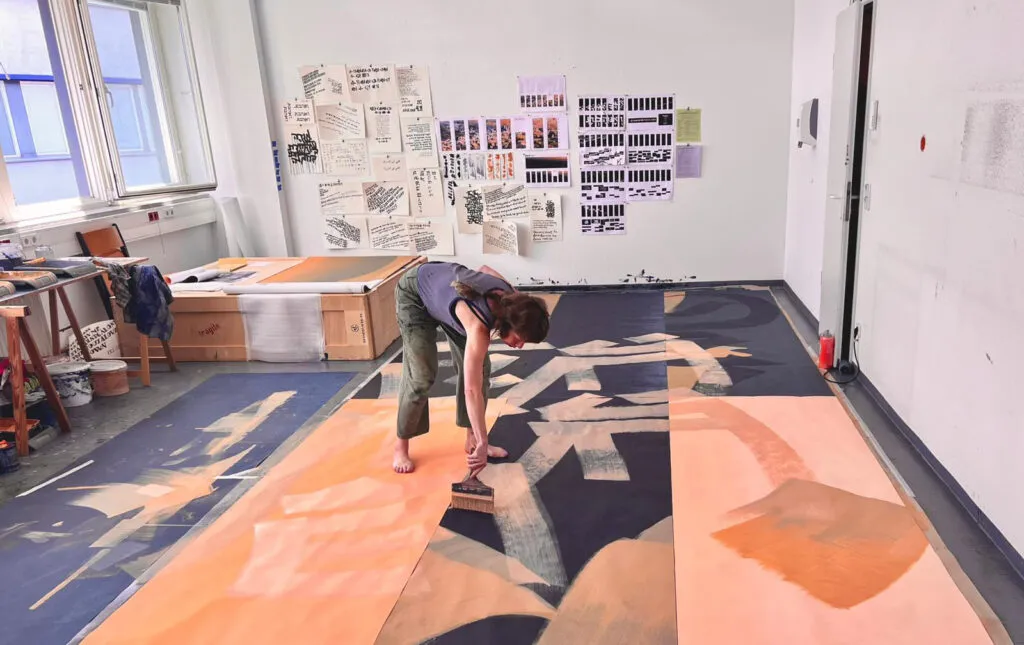
By Aviva Kapust, Chief Advancement and Impact Officer, Mural Arts Philadelphia
On September 26, 2025, Mural Arts Philadelphia and the Philadelphia Holocaust Remembrance Foundation will dedicate a new mural at Horwitz-Wasserman Holocaust Memorial Plaza. The artist behind the work, Ella Ponizovsky Bergelson, brings a deeply personal lens to the project. Born in Moscow, raised in Jerusalem, and now based in Berlin, her life and art are shaped by migration, layered histories, and cultural hybridity.
Rather than portraying the events of the Holocaust, Ella’s mural Lay-lah Lay-lah explores the aftermath of displacement, resilience, and the ongoing ways we inherit and reinterpret memory. Through community participation, archival fragments, and layers of text, she creates a work that is at once intimate and collective.
This project reflects Mural Arts Philadelphia’s ongoing commitment to using public art as a catalyst for dialogue, remembrance, and connection. It underscores the power of art to honor history while speaking to the present. Here, memory is not fixed but alive, layered into the city’s walls, contested, carried, and continually remade in the rhythms of daily life. The mural insists that remembrance is not only about what has been lost, but about how we imagine living together now and into the future.
I spoke with Ella about her family’s history, her artistic approach, and what she hopes this mural offers to Philadelphians and visitors for generations to come.
____
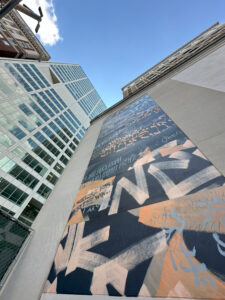
Aviva: Ella, you were born in Moscow, raised in Jerusalem, and now live in Berlin. How have those shifts across geography, language, and culture influenced your perspective as both a person and an artist?
Ella: First and foremost, they shaped me as a person, and from there as an artist. In my case, those two things are deeply intertwined. My work is always very personal. I think of myself as having a hybrid identity—different cultural and linguistic layers inside me that are constantly in dialogue with one another. There’s never just “one” Ella; there are many, all in conversation. And as I move through life, living in new places and taking in new perspectives, that conversation expands and grows richer.
I was born in Moscow in 1984, still during the Soviet Union. My family has a difficult history there. My grandparents (before my mother was even born) moved to Moscow in 1935. Before that, they lived in Berlin and earlier in Ukraine. My great-grandfather, a Yiddish writer and political activist, was part of the Jewish Anti-Fascist Committee. He advocated for socialism and fought against fascism. For that—and for refusing to abandon his mother tongue—he was imprisoned and executed in Moscow.
That legacy shaped my childhood. Even before I fully understood, I was born into an atmosphere where my family felt watched and had no freedom No freedom of speech, no freedom of movement. It was like being born into a prison.
In 1991, after the collapse of the Soviet Union, we emigrated to Israel. I was six years old. Moving to Jerusalem felt like landing on another planet: a new language, a new climate, a completely different universe.
Later, as an adult, I moved to Berlin. In a way, it felt like a return. My grandfather grew up there until he was 14. But I also came for my own reasons: Berlin struck me, and still does, as the cultural epicenter of Europe. I wanted to be surrounded by like-minded people and immersed in that creative energy. In a way, it’s the same reason my great grandpa, the writer, moved to Berlin a century ago.
Aviva: Your great-grandfather’s refusal to abandon his language and beliefs ultimately cost him his life. How does carrying that history shape the way you see your identity and the art you create?
Ella: It’s very present. What I carry most strongly, in my work and in my personality, is a sense of being rootless, or perhaps free from the obligation to tie myself to one national identity or geographic place. I feel part of many communities, but they aren’t defined by borders. That fluidity is something I inherited from generations before me. It’s how they lived, and it’s how I live.
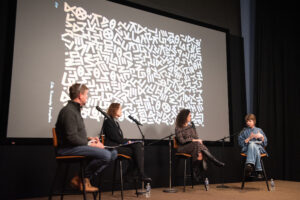
Aviva: For this commission, you chose not to portray the events of the Holocaust but to focus on its aftermath: displacement, othering, cultural survival. Why was that the right entry point for you?
Ella: I haven’t lived through the Holocaust. I can’t know what it was like firsthand. What I do know is how it’s remembered, how it’s told. And I’ve had the unique experience of encountering that memory culture from different perspectives: Soviet, Israeli, and German. Each one remembers the same event differently.
That realization opened a door for me. I wanted to explore how memory is shaped, how it changes depending on where you are, and what responsibility I have as an artist to carry those memories forward. Most importantly, I wanted to emphasize that the Holocaust is not a closed chapter in history. Its domino effect is still with us, still shaping the world.
Aviva: You’ve described living as “othered” in Russia, Israel, and Germany. How did those personal experiences of belonging and exclusion inform the themes and textures of this mural?
Ella: Othering is something that appears in almost everything I create, because it has always been part of my life. In Russia, we weren’t Russians, we were Jews. In Israel, we weren’t Israeli, we were Russians. In Berlin, I am not just an artist; I am “the Jewish artist.” It’s a label that follows me, like I’m a rare or endangered species.
Those experiences were painful but transformed to be enriching. I feel privileged to integrate all those different cultures in me. And in the mural, the theme of othering naturally connects to the history of the Holocaust. The Nazis sought to create a society that was uniform and Aryan, which is impossible—human beings have always been on the move, always mixed, always shifting. In the mural, I tried to show that visually: overlapping languages and cultural resonances, sometimes clashing, sometimes blending, ultimately creating a polyphonic whole.
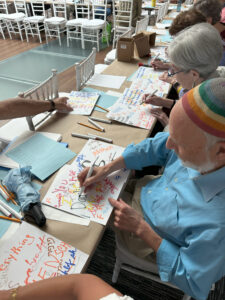
Aviva: A defining feature of this project is the Philadelphia community’s voice—woven through ”Memory Forms”, lullabies, and personal stories. What did you discover in that process, and how did those encounters transform the work?
Ella: That process was essential. I wasn’t coming to Philadelphia as an insider, so I needed to meet the community. I participated in three community events where people could listen, respond, and share. From there, I created what I called “Memory Forms”—they look like migration documents, but they guide people to recall early memories: food their grandmother cooked, lullabies, the feel of their childhood home.
I collected hundreds of these, and all the language in the mural comes from those contributions. Researching them taught me so much, but what moved me most was how familiar many of them felt. I came across songs, stories, and sayings that I knew from my own family. It made me feel deeply connected to people I’d never met, across continents. That sense of connection is what I hope others experience when they see the work.
Aviva: Creating art about the Holocaust carries extraordinary weight. What made you decide to take on this subject, and how did you navigate the risks and sensitivities involved?

Ella: I hesitated. The Holocaust is an incredibly sensitive, complex subject. I live in Berlin, where the history of the war and the Holocaust is still very present—it isn’t just in the past, it’s part of daily life. So yes, I was cautious.
In the end, I decided that if I approached the project from a deeply personal place—both my own experience and the experiences of people I engaged with in Philadelphia—then the work would carry integrity. That way, it isn’t only mine; it belongs to the community as well. People can see themselves in it, take ownership of it, and share in the responsibility of carrying it forward.
Aviva: The mural is placed in the Holocaust Memorial Plaza but is also visible to anyone passing by, with or without context. What do you hope viewers will carry with them—whether they stop intentionally or encounter it by chance?
Ella: Migration, cultural complexity, and linguistic diversity are timeless. They were relevant a thousand years ago, and they will be relevant a thousand years from now. Even if someone doesn’t understand a single word of the mural, they will still feel the layers of language and texture.
I hope people walk away reflecting on their own journey: How did I arrive here? What brought me here? Which ancestors shaped this path? I want the work to spark those connections, across time and generations.
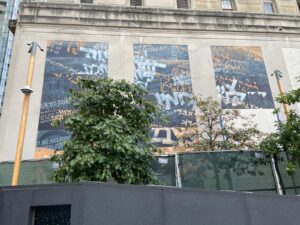
Aviva: Finally, what else feels important for you to share about this mural, your process, or what it means to you personally?
Ella: One of the most moving moments for me was speaking to my mother about the project. I told her that the songs she sang to me as a child are now inscribed on a huge public wall in the center of Philadelphia. For me, that was about bridging the private and the public, uniting my inner world with the outside world. There’s a powerful tension that is created between the intimate contributions and the busy public location.
It made me realize that, in some ways, this mural is for my mother, my grandmother, my grandfather, and even my great-grandfather, whom I never met. It’s for all those who came before me and shaped who I am.
At the same time, it’s also a response to the present. One of the biggest problems in the world today is our inability to hold multiple perspectives, to listen across differences. In this mural, many languages and voices sit together in one space, sometimes in tension but ultimately in harmony. That was my goal: to create a work that embraces contradiction, complexity, and connection.